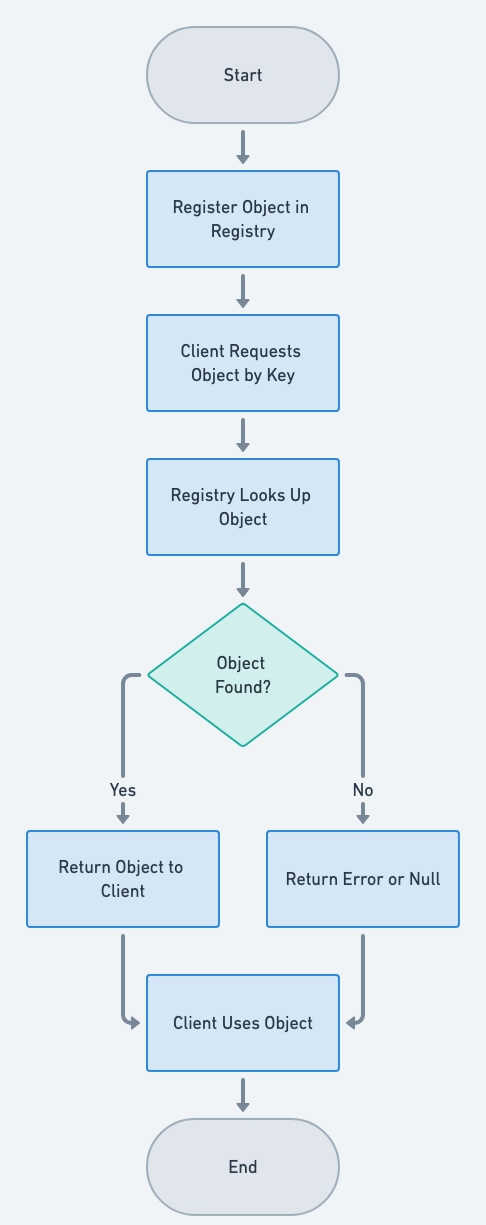Registry Pattern in Java: Implementing a Centralized Control Mechanism for Java Objects
Intent of Registry Design Pattern
Registry Design Pattern centralizes the creation and management of a global set of objects, providing a single point of access and ensuring controlled instantiation.
Detailed Explanation of Registry Pattern with Real-World Examples
Real-world example
In a large corporation, managing IT assets such as laptops, desktops, servers, and software licenses can be challenging. To streamline this process, the company uses a centralized IT Asset Management System, which functions as a Registry.
- The system provides a single point of access for registering, tracking, and retrieving information about all IT assets.
- When a new device or software is procured, it is registered in the system with details such as serial number, purchase date, warranty period, and assigned user.
- IT staff can query the system to get details about any asset, check its current status, and update information as needed.
- This centralized management promotes efficient utilization and maintenance of assets, ensures compliance with software licenses, and helps in planning for upgrades or replacements.
In this analogy, the IT Asset Management System acts as a Registry, managing the lifecycle and providing global access to information about IT assets within the organization.
In plain words
Registry is a well-known object that other objects can use to find common objects and services.
wiki.c2.com says
A registry is a global association from keys to objects, allowing the objects to be reached from anywhere. It involves two methods: one that takes a key and an object and add objects to the registry and one that takes a key and returns the object for the key. It's similar to the MultitonPattern, but doesn't restrict instances to only those in the registry.
Flowchart

Programmatic Example of Registry Pattern in Java
The Registry design pattern is a well-known pattern used in software design where objects are stored and provide a global point of access to them. This pattern is particularly useful when you need to manage a global collection of objects, decouple the creation of objects from their usage, ensure a controlled lifecycle for objects, and avoid redundant creation of objects.
First, we have the Customer record. It represents the objects that will be stored in the registry. Each Customer has an id and a name.
public record Customer(String id, String name) {
@Override
public String toString() {
return "Customer{"
+ "id='" + id + '\''
+ ", name='" + name + '\''
+ '}';
}
}Next, we have the CustomerRegistry class. This class is the actual registry where Customer objects are stored. It provides methods to add and retrieve customers. The CustomerRegistry is a singleton, meaning there is only one instance of it in the application.
public final class CustomerRegistry {
@Getter
private static final CustomerRegistry instance = new CustomerRegistry();
private final Map<String, Customer> customerMap;
private CustomerRegistry() {
customerMap = new ConcurrentHashMap<>();
}
public Customer addCustomer(Customer customer) {
return customerMap.put(customer.id(), customer);
}
public Customer getCustomer(String id) {
return customerMap.get(id);
}
}Finally, we have the App class. This class demonstrates how to use the CustomerRegistry. It creates two Customer objects, adds them to the CustomerRegistry, and then retrieves them.
public class App {
private static final Logger LOGGER = LoggerFactory.getLogger(App.class);
public static void main(String[] args) {
CustomerRegistry customerRegistry = CustomerRegistry.getInstance();
var john = new Customer("1", "John");
customerRegistry.addCustomer(john);
var julia = new Customer("2", "Julia");
customerRegistry.addCustomer(julia);
LOGGER.info("John {}", customerRegistry.getCustomer("1"));
LOGGER.info("Julia {}", customerRegistry.getCustomer("2"));
}
}In this example, the CustomerRegistry provides a global point of access to Customer objects. This allows us to manage these objects in a centralized way, promoting reuse and sharing, and facilitating decoupling between components.
Running the example produces the following output:
09:55:31.109 [main] INFO com.iluwatar.registry.App -- John Customer{id='1', name='John'}
09:55:31.113 [main] INFO com.iluwatar.registry.App -- Julia Customer{id='2', name='Julia'}When to Use the Registry Pattern in Java
- When you need to manage a global collection of objects.
- When you need to decouple the creation of objects from their usage.
- When you need to ensure a controlled lifecycle for objects, such as services or resources.
- When you want to avoid redundant creation of objects.
Real-World Applications of Registry Pattern in Java
- Managing database connections in an enterprise application.
- Providing a central place to register and retrieve services or components in a modular application.
- Creating a central configuration registry that various parts of an application can access.
Benefits and Trade-offs of Registry Pattern
Benefits:
Key advantages of adopting the Registry pattern in Java
- Centralizes object management, making the application easier to maintain.
- Promotes reuse and sharing of objects, which can reduce memory footprint and initialization time.
- Facilitates decoupling between components.
Trade-offs:
- Can become a bottleneck if not implemented efficiently.
- May introduce a single point of failure if the registry is not designed to be fault-tolerant.
- Increases complexity in managing the lifecycle of objects.
Related Patterns
- Singleton: Often used in conjunction with the Registry to ensure there is a single instance of the Registry.
- Factory: Used to encapsulate the instantiation logic that might be needed when objects are retrieved from the Registry.
- Service Locator: A pattern that is similar in intent and structure, often used interchangeably with the Registry.
- Dependency Injection: Provides an alternative method for managing dependencies, which can sometimes replace the need for a Registry.
- Multiton: Similar to the Registry in that it manages multiple instances, but does so based on keys, ensuring only one instance per key.